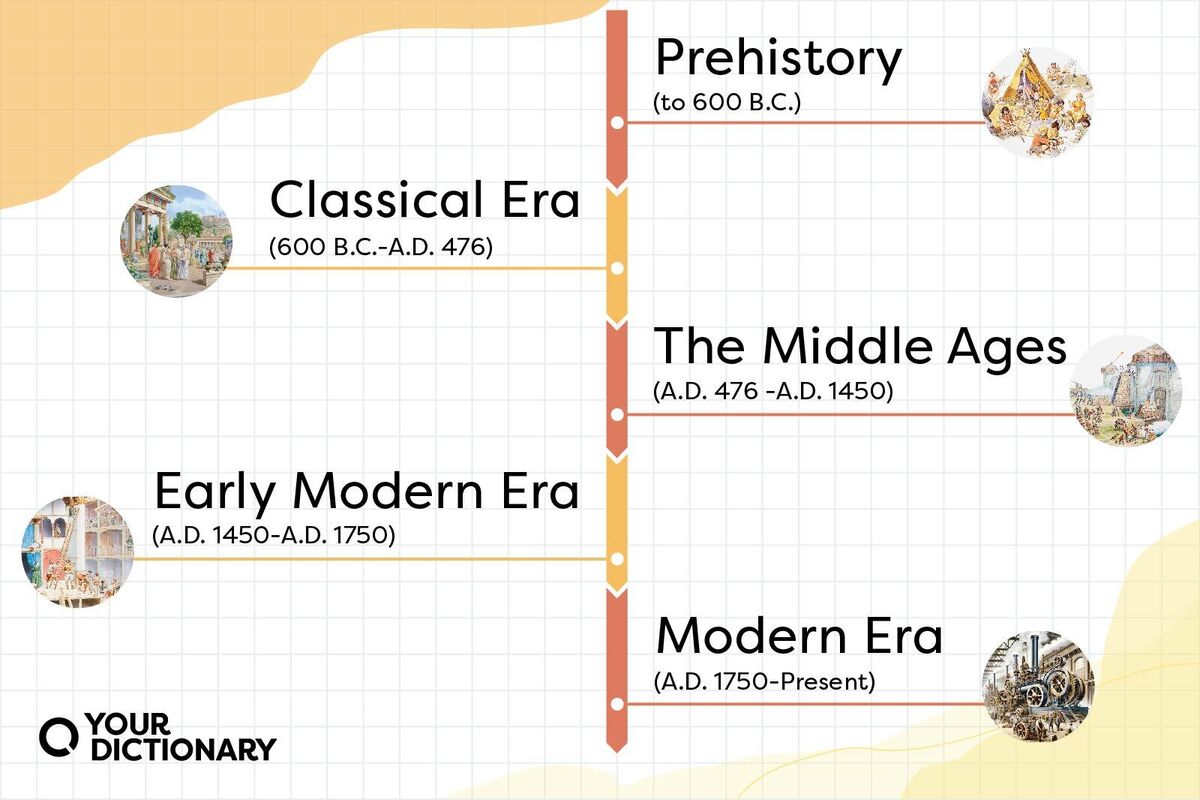
Historians rely on written records and archaeological evidence to understand more about human history. They use these resources to divide human existence into five main historical eras: Prehistory, Classical, Middle Ages, Early Modern, and Modern eras. Learn the main civilizations, technological achievements, important historical figures, and significant events that arose during these major periods in history.
Historical Eras Timeline
Historians define human history by five major eras.
| Major Historical Eras | Dates |
|---|---|
| Prehistoric Era | 2.5 million years ago - 600 B.C.E. |
| Classical Era | 600 B.C.E. - 476 C.E. |
| The Middle Ages | 476 C.E. - 1450 C.E. |
| Early Modern Era | 1450 C.E.- 1750 C.E. |
| Modern Era | 1750 C.E. - Present |
Prehistory (2.5 million years ago - 600 B.C.E)
The Prehistoric era in human history reflects the period between the appearance of humans on the planet (roughly 2.5 million years ago) and 600 B.C.E. or 1200 B.C.E., depending on the region. It indicates the period on Earth in which there was human activity but little to no written records of human history. This era is also known as the Foundational era, as many foundations of human civilization occurred during this span of time.

Major Periods of the Prehistoric Era
The Prehistoric era can be divided into three shorter eras based on the advancements that occurred in those time periods. They include:
- The Stone Age (2.5 million B.C.E. to 3000 B.C.E.): Documents the human migration from Africa and the first use of tools by Neanderthals, Denisovans, and early humans
- The Bronze Age (3000 B.C.E. to 1300 B.C.E.): Humans settle in Mesopotamia, the Indus Valley, and ancient Egypt
- The Iron Age (1300 B.C.E, to 600 B.C.E.): Formation of planned cities; the introduction of ironworks, steel, and writing systems occurs
Need to Know: Modern historians no longer use BC ("Before Christ") and AD ("Anno Domini") to define history because of their Western-centric and imprecise nature. Instead, they use BCE ("Before the Common Era") and CE ("Common Era") to denote a place in historical time.
Major Advancements in the Prehistoric Era
Prehistory isn't nearly as dull as some make it out to be. Our ancestors made many important advacements during this span of time, some of which we still use today.
A few of the important inventions and advancements made in prehistory include the following:
- The wheel is invented.
- Metalworking techniques are invented.
- Sewing needles are created.
- Clay pottery techniques are developed.
- Axes and blades are created.
- Paper is invented.
Classical Era (600 B.C.E. - 476 C.E.)
The Classical era, also known as Classical antiquity, began roughly around 600 B.C.E. in most of the world. It marked the beginning of a philosophical period in world history as well provided the first recorded sources of human history. Politically, the Classical era saw the rise – and fall – of most of the world's first major empires.
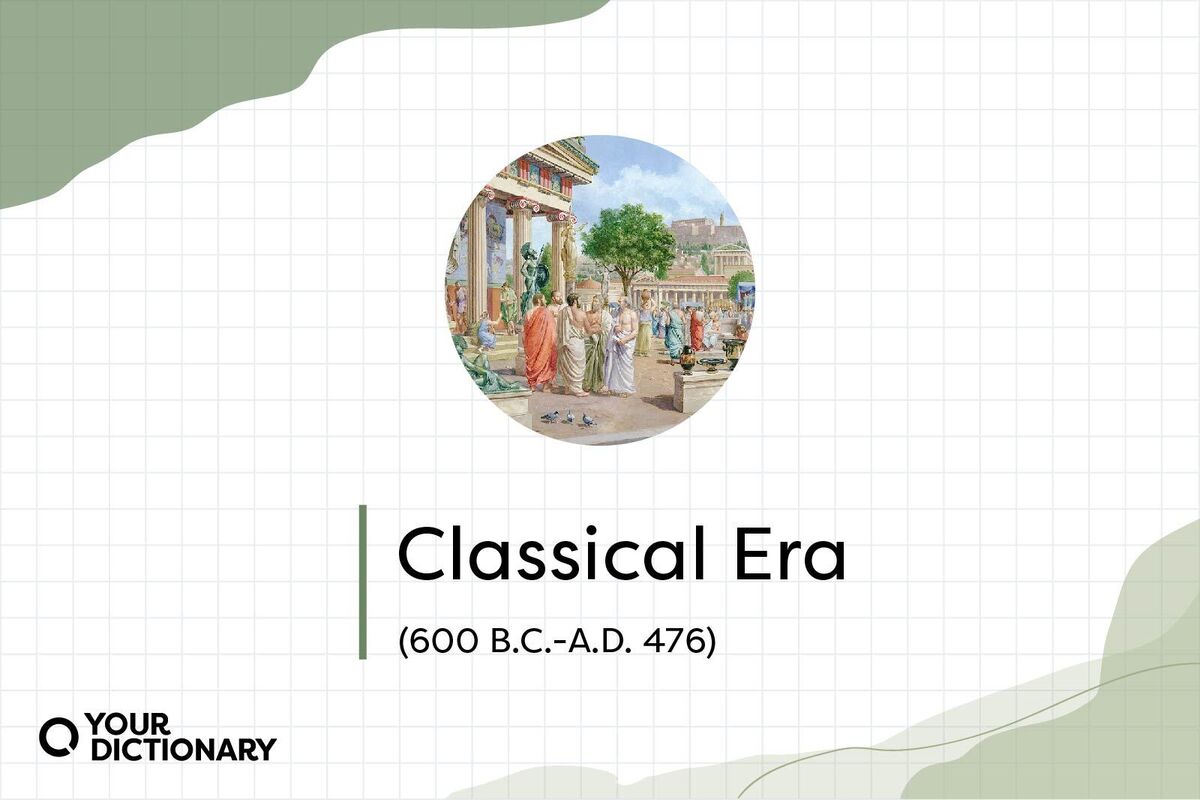
Classical Civilizations and Empires
The Classical era was mainly centered around the civilizations on the Mediterranean Sea and their contributions to world culture. These empires included:
- Ancient Greece (600 B.C.E. to 600 C.E.): Empire that created a lasting foundation of democracy, philosophy, mathematics, drama, and poetry
- Ancient Rome (753 B.C.E. to 476 C.E.): Political power that developed many things, including a codified legal system, irrigation, architecture, city roads, and Christianity
- Persian Empire (550 B.C.E. to 330 B.C.E.): Middle Eastern empire that practiced Zoroastrianism before Islam and fell to Alexander the Great in 330 B.C.E.
- Maurya Empire (321 B.C.E. to 185 B.C.E.): Far-reaching Indian empire that helped advance the South Asian region with extensive trade systems and artistic output
- Byzantine Empire (285 C.E. to 1453 C.E.): Mediterranean culture that incorporated practices and beliefs from ancient Greece and Rome; the only major power not to fall until after the Renaissance
Need to Know: You may also see antiquity used to describe the ancient past. Generally, antiquity encompasses the pre-Medieval period, including the Classical and Prehistoric eras.
Significant World Events From the Classical Period
Human civilization really starts to heat up during the Classical era. From wars to disasters, these are some of the most significant events to take place during this time period.
- Upper and Lower Egypt are united circa 3,000 B.C.E.
- Construction on the Great Wall of China beings circa 770 B.C.E.
- The first Olympic Games are held between 776 B.C.E. and 393 C.E.
- The Battle of Thermopylae between Persia and several Greek city-states took place in 480 B.C.E.
- Mount Vesuvius erupted in 79 C.E. and destroys Pompeii, Herculaneum, Oplontis, Stabiae, and more.
The Middle Ages (476 C.E. - 1450 C.E.)
The Middle Ages is also known as the Medieval Period or Post-Classical era. Historians have referred to the early part of this period as the Dark Ages due to the loss of recorded history after the fall of the Roman Empire in 476 C.E.
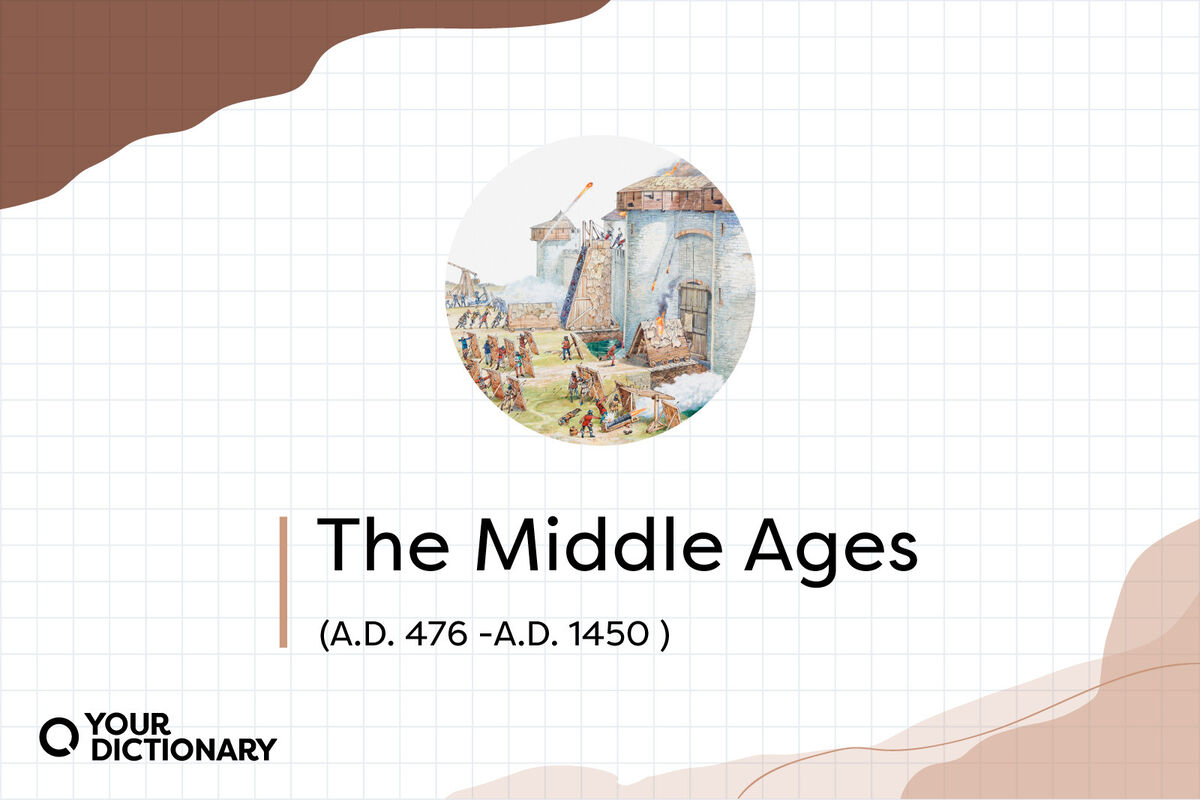
Significant Periods of the Middle Ages
The Middle Ages was an unstable period that lasted for nearly a millennium. Historians often group the era into three distinct periods: the Early Middle Ages, the High Middle Ages, and the Late Middle Ages.
- Early Middle Ages (476 C.E. to 1000 C.E.): This period shows most powers rebuilding after the collapse of the Roman Empire and the beginning of Islamic rule in the Middle East
- High Middle Ages (1000 C.E. to 1250 C.E.): 250-year period that saw the height of the Catholic church’s power in the Crusades
- Late Middle Ages (1250 C.E. to 1450 C.E.): A period that saw the Black Plague, the beginning of European exploration, and the invention of the printing press
Famous Figures From the Middle Ages
When you think of the Middle Ages, celebrities don't usually come to mind. But there are so many important historical figures to come out of this period, and these are just a few.
- Ibn Sina (980 C.E. to 1037 C.E.): Muslim physician and philosopher who wrote the seminal text The Canon of Medicine and is known as the Father of Modern Medicine
- Charlemagne (748 C.E. to 814 C.E.): King of the Franks who united much of continental Europe and ruled the Carolingian Empire
- Richard the Lionheart (1157 C.E. to 1199 C.E.): Prominent English King and crusading military leader
- Donatello (1386 C.E. to 1466 C.E.): Italian sculptor who revitalized Classical sculpting styles and conventions during the Renaissance
- Joan of Arc (1412 C.E. to 1431 C.E.): Catholic French warrior turned saint who was executed for heresy
Early Modern Era (1450 C.E. - 1750 C.E.)
The Early Modern Era, which immediately followed the Middle Ages, saw a resurgence of the values and philosophies from the Classical era. When you think of Leonardo da Vinci, William Shakespeare, Johann Sebastian Bach, and Christopher Columbus, you’re thinking of the Early Modern Era.
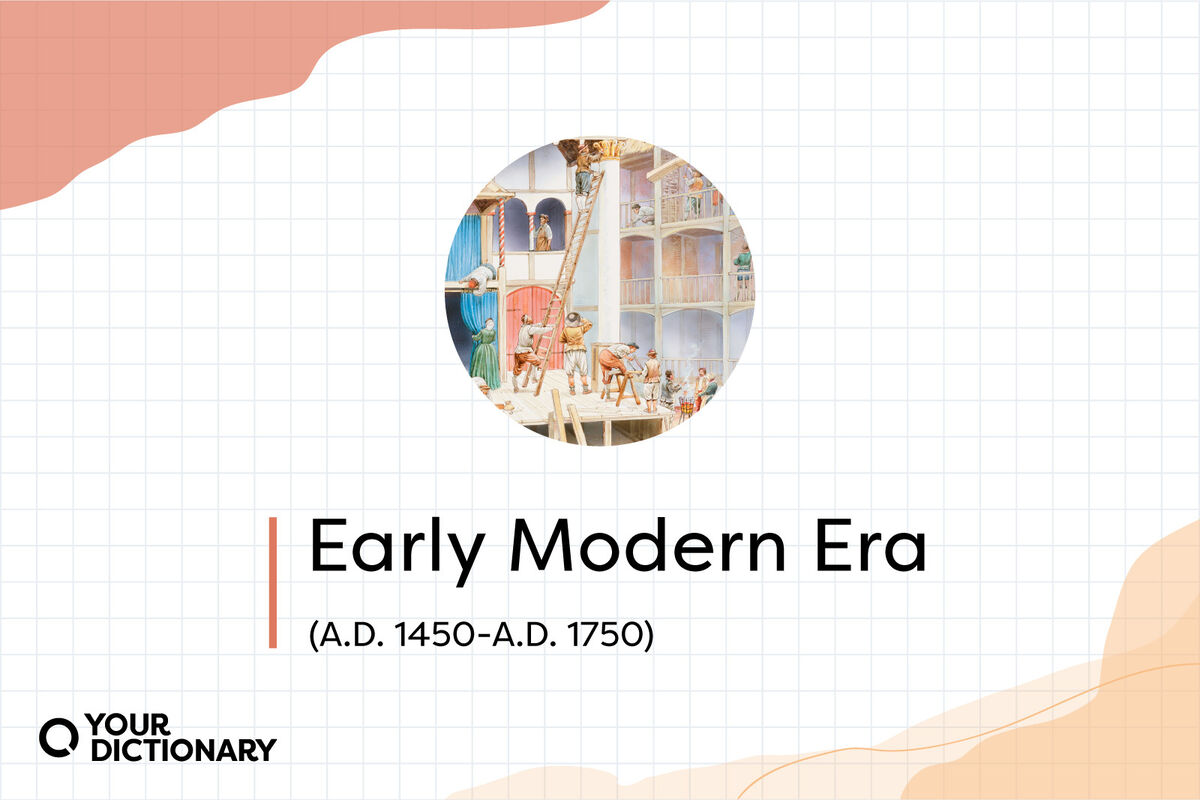
Movements of the Early Modern Era
The major movements in politics, religion, and geography helped to guide human civilization into the Modern era. These movements include:
- Renaissance Humanism (1400 C.E. to 1500 C.E.): A break from medieval scholasticism that incorporated Classical thought into Early Modern ideas
- Protestant Reformation (1517 C.E. to 1648 C.E.): Religious movement in which Lutheranism (started by Martin Luther) broke with the Catholic church and redefined Christianity
- The European Renaissance (1450 C.E. to 1600 C.E.): Known as a cultural “rebirth” in art, music, literature, society, and philosophy
- The Age of Exploration (aka Age of Discovery) (1415 C.E. to 1643 C.E.): A period of international exploration around the globe funded by European interests; laid the foundation for European colonialism.
- The Enlightenment (aka Age of Reason) (1650 C.E. to 1800 C.E.): An intellectual movement that saw the re-examination of politics, economics, and science before giving way to Romanticism in the 19th century
Fast Fact: The European Renaissance, or “rebirth,” occurred during this period, as well as the discovery and colonization of the Americas and the Age of Enlightenment.
Important Philosophical & Scientific Advancements From the Early Modern Era
The foundation for so many of our contemporary philosophical and scientific beliefs was established during the Early Modern era. Here are just a fraction of these significant developments:
- Social Contract Theory: A sociopolitical theory proposed by Thomas Hobbes that explores the relationship between a people and its governing body
- 95 Theses: Martin Luther's proposal for the dispensation of indulgences, which lit the fire on burgeoning religious unrest in continental Europe
- The Scientific Method: A formalized process for testing scientific theories using inductive reasoning explored in Francis Bacon's Novum Organum
- The Three Laws of Motion: Isaac Newton proposed his three laws of motion in 1687
- Copernican Heliocentrism: The theory that the sun sits motionless at the center of the universe with the planets orbiting around it
Modern Era (1750 C.E. - Present)
The influences of both the Renaissance and the Enlightenment led to a technological boom in the Modern era, also known as the Late Modern era. The world of politics was rocked by wars, revolution, and the end of monarchial rule in many countries. The Modern era is truly a cumulation of hundreds of thousands of years of human development.
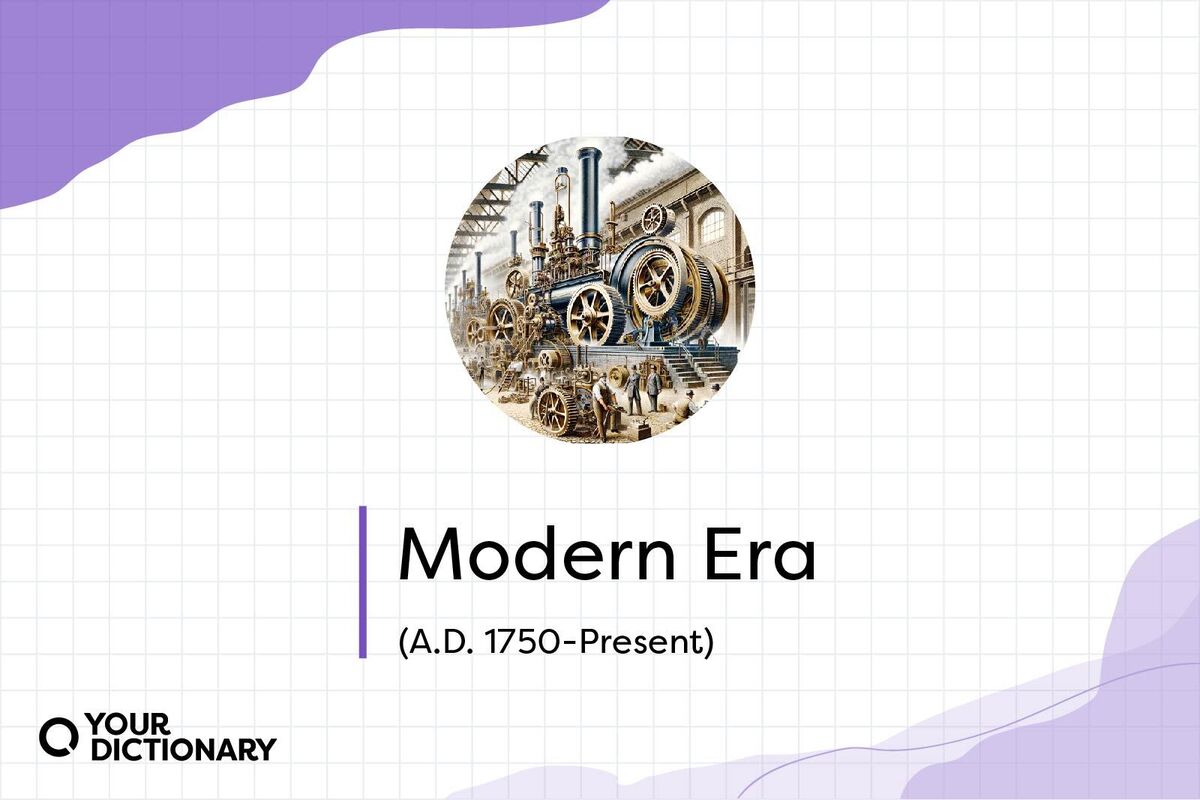
Major Periods of the Modern Era
Because our history of the last three centuries is so well documented, it’s possible to examine each period of the Modern era on its own. These eras include:
- First Industrial Revolution (1760 C.E. to 1840 C.E.): Beginning of the modern era that saw several technological innovations, including the invention of the cotton gin, the increase of city factories and mills, and the completion of the Erie Canal
- Revolutionary Period (1764 C.E. to 1848 C.E.): Period of revolutions around the world, including the American Revolution, French Revolution, Spanish-American Wars for Independence, Italian Revolutions, Greek War of Independence, and the Spring of Nations
- Age of Imperialism (1800 C.E. to 1914 C.E.): Century of time in which France, Britain, Spain, the Netherlands, and the United States colonized other nations around the world
- Victorian Era (1837 C.E. to 1901 C.E.): Reign of Queen Victoria I that saw increased urbanization, the American Civil War, and the end of African slavery
- Second Industrial Revolution (aka Technological Revolution) (1869 C.E. to 1914 C.E.): Period in which the light bulb, the telephone, the airplane, and the Model T automobile were invented
- World War I (1914 C.E. to 1918 C.E.): Worldwide conflict centered in Europe; also known as the Great War
- Great Depression (1929 C.E. to 1939 C.E.): Extended period of worldwide economic hardship that started with the stock market crash in 1929
- World War II (1939 C.E. to 1945 C.E.): Wartime period that began with Germany’s invasion of Poland and ended with the surrender of Japan, the last standing Axis power
- Cold War (1945 C.E. to 1991 C.E.): Period of international conflict, executed in a series of proxy wars and cultural competitions, between the United States and the Soviet Union
- Contemporary Period (aka the Information Age) (1945 C.E. to present): The period in which technological advances define social, economic, and political life
Major Cultural Moments From Modern History
Culture is a uniquely compounding element of human society, and you can see so much of our past reflected in contemporary culture. Just a few of the cultural moments that helped define modern history include:
- Joseph Nicéphore Niépce takes the oldest surviving photograph in 1826.
- The first recorded human voice is captured in 1860.
- The first motion-picture film, the Roundhay Garden Scene, is filmed in 1888.
- Coca-Cola is bottled for the first time in 1894.
- The first Academy Awards ceremony is held in 1929.
- The first modern musical — where the songs are used to further the plot — Oklahoma! debuts on Broadway in 1943.
- The MTV television channel debuts in 1981.
- The Berlin Wall falls in 1989.
The Historical Timeline Is Always Evolving
So where does the Modern era end and the next era begin? The only way to know is to investigate these historical eras – and to learn more about how society evolves over time. Continue your trip through human history and society with a list of key sociology terms and concepts.